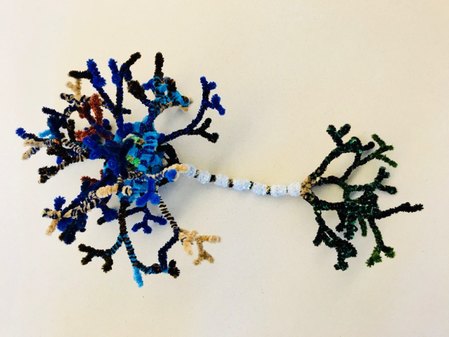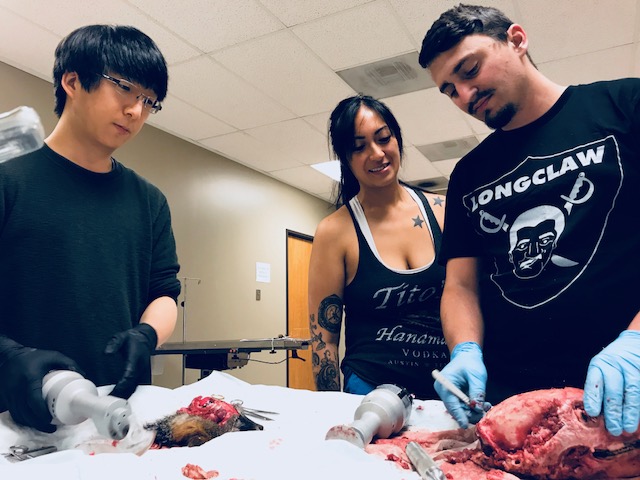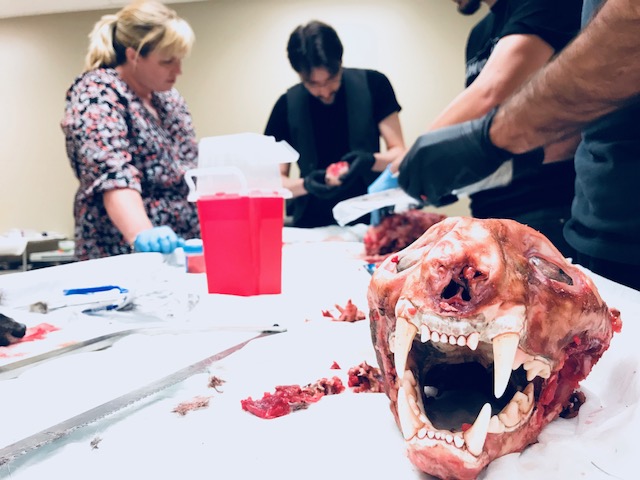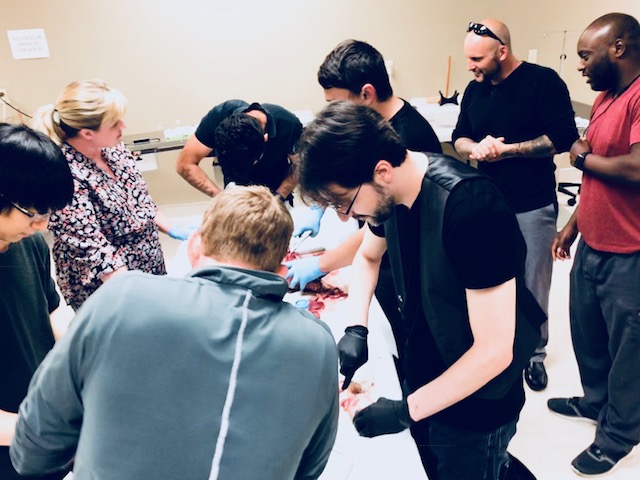“It is not my intention to be fulsome, but I confess that I covet your skull.” –Arthur Conan Doyle, The Hound of the Baskervilles

Native stories are often seasonal, and those who closely observe fellow denizens of our natural world tell instructive tales, and create dances and songs relating the richness of animal behavior. Brain scientists are now discovering how neuroanatomy relates to this complexity – how the underlying structure and function of cerebral networks contributes to what each animal perceives, thinks and does…

NW Noggin in Heppner and Ione, Oregon
LEARN MORE: Brain & baby goats!
LEARN MORE: Soup for Brains!
We’re excited to collaborate with Grande Ronde and Siletz tribal communities, and bring our art and neuroscience outreach participants to Oregon’s Lincoln and Yamhill counties in October for a Spirit Mountain Community Fund supported effort to explore these enticing connections with students, teachers, artists, storytellers and musicians…

LEARN MORE: Synapses & Stories: Coyote, Grizzly & their Brains!
When Denesa Lockwood, our newest Brain Board member, learned about this project, she reached out to Wayne Sherrard of Wayne’s Taxidermy in Yoncalla, Oregon, who generously offered the heads of multiple animals, including cougar, badger and black bear – plus a whole fox and squirrel!

Badger and cougar heads…
LEARN MORE: Waynes Taxidermy
Taxidermy has a long history. The word comes from taxis (“arrangement”) plus derma (“skin”) in Greek. Charles Darwin was an experienced taxidermist. He learned his craft at Edinburgh University from John Edmonstone, an expert who also taught Darwin about what to expect in South America. Edmonstone had once been enslaved in Guyana, and Darwin, of course, relied on his invaluable knowledge and skills during his famous voyage on the H.M.S. Beagle…

Photo by Elliot & Fry: Darwin would not have collected Galápagos finches on his voyage if he couldn’t properly prepare them using taxidermy skills he learned from John Edmonstone…
LEARN MORE: You Should Know: John Edmonstone
LEARN MORE: John Edmonstone: The freed slave who inspired Charles Darwin
LEARN MORE: John Edmonstone: The Black genius who schooled Charles Darwin
LEARN MORE: Exploring the nature of science: a case study of Charles Darwin’s way of knowing
LEARN MORE: Manual of Taxidermy: A Complete Guide in Collecting & Preserving Birds & Mammals
LEARN MORE: Methods in the art of taxidermy
Denesa stored these donations in her home freezer, but was understandably eager to carry out dissections asap…

Could frozen animal heads be successfully dissected, with the brains intact? What specific tools did this require? Where could we do this? And what might we learn from direct anatomical exploration about brains, perception, cognition and behavior..?

Thank goodness for BioGift! Huge supporters of STEM and STEAM, Andrew, Michael and Miguel gamely welcomed us back – and this time with game – to their spotless body donation labs for more adventures in brain extraction.

Cougars, badgers and bears – oh my!
LEARN MORE: BioGifting Brains
LEARN MORE: A BioGift of Brains

Front to back: badger, black bear, cougar, squirrel, fox…

“I profess to learn and to teach anatomy not from books but from dissections, not from the tenets of Philosophers but from the fabric of Nature.” –William Harvey
LEARN MORE: William Harvey and the discovery of the circulation of the blood
Dissection is a uniquely powerful technique for acquiring intimate, accurate and persistent knowledge of anatomy (and neuroanatomy) relevant to research, medicine, and a better understanding of the “fabric of Nature.”

Leonardo da Vinci: The Mechanics of Man
Dissection inspired famous Greek scientists like Galen before infamously deemed “blasphemous” during the Middle Ages by religious authorities, who apparently didn’t want people looking too deeply into the reality of our world. Yet students of medicine and physiology, artists, hunters, taxidermists and others who were fascinated and curious about how we and other animals are constructed, and what we’re made of, continued to explore…

The dissecting room at St. George’s Hospital
LEARN MORE: Happy birthday, Gray’s Anatomy
LEARN MORE: Human cadaveric dissection: historical account from ancient Greece to the modern era
LEARN MORE: The discovery of the body: human dissection and its cultural contexts in ancient Greece
LEARN MORE: The Changing Role of Dissection in Medical Education
LEARN MORE: Discussing dissection in anatomy education
LEARN MORE: Brains in jars: artists’ fascination with anatomy
LEARN MORE: Leonardo da Vinci and Dissection
Following a long and storied tradition, our intrepid saw-brandishing students included Jordan Ray, Jade Osilla and Matt Marcel from Psychology at Portland State University, Denesa from Behavioral Neuroscience at OHSU, Robert Martin from the University of San Diego, and Jeehoon Jung from WSU Vancouver…

“I strive that in public dissection the students do as much as possible…by comparing their studies one with another they will properly understand this part of medicine.” -Andreas Vesalius
LEARN MORE: Andreas Vesalius: Celebrating 500 years of dissecting nature
LEARN MORE: Vesalius’s Renaissance anatomy lessons
This being Portlandia, my own kids and their friends used to raise, slaughter and pluck backyard turkeys each fall, and here at BioGift everyone dove right in…

“I’m not squeamish at all. As a child I dragged a dead squirrel home on my skateboard and cut it open and tried to look at its brain.” – Jessica Biel

From Denesa: “My initial idea for asking Wayne for the brains came after watching him throw one away; for his clients often choose only to save the antlers and/or skulls, but not their contents! What a waste, I thought, knowing how valuable our preserved brain collection is for education. How cool would it be to showcase a bear or a deer brain in addition to the other animal brains we already present (pig, fish, mouse, etc.)?”

“I thought it would be a cinch to dissect out these brains, as I have almost 20 years of experience dissecting rodent brains in the lab. But I couldn’t have been more wrong! This project really made me develop an appreciation for the proper tools! I am very appreciative to the team at Biogift, the loan of their facility and tools, and our confident volunteers!”

The Mopec autopsy saw proved invaluable, once we’d begun warming the icy craniums…

Frozen black bear head…

Thawing in hot water…
Some compelling comparisons with human skulls were quickly apparent. It was striking, for example, to realize how that thick, wide bony face of a cougar gave way to far thinner, smaller plates around the brain itself! Though to reach that thinner, smaller brain-casing, you had to cut away substantial muscle, muscle that once generated significant force in this cougar’s toothy, threatening jaw…

“Anatomy is destiny.” –Sigmund Freud

So much muscle behind the face!

The brain-encasing portions of the skull were much thinner, and smaller than we expected…



The brain revealed!
(And thick bite force muscle to the right and left)
LEARN MORE: Big Cat Coalitions: A Comparative Analysis of Regional Brain Volumes in Felidae
LEARN MORE: Bite forces and evolutionary adaptations to feeding ecology in carnivores
LEARN MORE: Cyclists tried to scare cougar but it attacked, killing 1
Another fascinating discovery from direct anatomic examination was the extraordinarily extensive series of maze-like olfactory channels beyond the nostrils of the black bear, an animal with a more elongated, somewhat dog-like skull than we expected…


Mammalian nasal cavities let us breathe, regulate the air temperature, and are critical for olfaction (the sense of smell). They are surprisingly complex structures packed with thin, winding sheets of bone called turbinals that are covered with specialized neurons (olfactory receptors) which selectively latch on to chemicals in the air (odorants). The turbinals (or turbinates) increase the amount of surface area for detecting odorants, and also appear to differentially direct airflow, depending on whether the animal is breathing in, or out…

FIGURE: Sagittal section of the canine (dog) nasal airway
Animals like dogs and bears are considered more sensitive and attuned to their olfactory environments than we are. They have long been referred to as macrosmatic, rather than microsmatic, although there is evidence that humans have better olfactory skills than previously assumed…
LEARN MORE: Poor Human Olfaction is a Nineteenth Century Myth
However, the bear’s immersion in the world of smells is arrestingly reflected in the vivid complexity of its nasal architecture…


FIGURE: (a) A sagittal section of the canine nasal airway (b) For comparison, a sagittal view of the human nasal airway demonstrates the absence of an olfactory recess in the human nose (courtesy Hornung 2006). Here, the delineation of the olfactory region is as illustrated by Lang (1989).
LEARN MORE: The fluid dynamics of canine olfaction: unique nasal airflow patterns as an explanation of macrosmia
LEARN MORE: Respiratory and olfactory turbinal size in canid and arctoid carnivorans

We spent almost four hours making discoveries about comparative neuroanatomy, improving our skills with scalpels and saws, and preparing specimens for stimulating outreach ahead. There is something so authentic about these hands on activities, about doing things and making things, teaching and learning “in real life” that motivates, engages and informs the way nothing else can…





“At moments it felt like I was cutting up a whole chicken in my kitchen, but with better tools…”

From Matt Marcel at PSU: “The Biogift/Noggin event was an impressive experience. I remember feeling trepidation and curiosity when it came time to use an autopsy saw on the badger skull, but learning to finesse the tool felt like an artistic practice.”

“The brain inside was much thinner compared to a human’s and it is a marvel that such a small mass, with significantly fewer gyri, represents the existence of a badger. Many thanks to Biogift, NWNoggin, and the specimen donator!”

We have new experience and new knowledge – and great stories! – from exploring animal anatomy that we’re excited to share with Grande Ronde and Siletz schools this fall. Our thanks as well to Wayne Sherrard of Wayne’s Taxidermy, Andrew, Michael and Miguel from BioGift, and Denesa, for (among multiple other essential contributions!) storing specimens in her family’s fridge!



